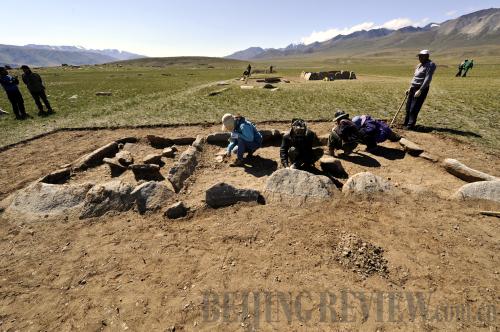|
 |
|
ANCIENT CITY: A bird's eye view of the Shimao site in Shaanxi Province on November 8, 2012 (XINHUA) |
Six most significant new findings in the year 2012 across the country were announced at the annual New Archeological Discoveries Forum, held by the Institute of Archeology of the Chinese Academy of Social Sciences (CASS) in Beijing on January 9.
Professor Wang Wei, head of the institute, said the discoveries included the Neolithic Shunshanji site in Sihong, Jiangsu Province; the Neolithic Shimao site in Shenmu, Shaanxi Province; the Bronze Age Adunqiaolu site and cemetery in Wenquan, Xinjiang Uygur Autonomous Region; the Spring and Autumn Period (770-476 B.C.) Jiwanggu Tomb in Yishui, Shandong Province; the Eastern Wei (534-550) and Northern Qi (550-577) period Buddhist temple and stone statues found at the Yecheng site in Hebei Province; and the Hailongtun fortress site in Zunyi, Guizhou Province.
"Some findings might not be sensational, but for us archeologists, they have remarkable significance," he said.
The Neolithic Shunshanji site in Sihong County is a prehistoric settlement relic with an 8,000-year history. It is the first such site to be found in the middle and lower Huaihe River valley.
The site covers an area of 175,000 square meters. Archeologists have excavated 92 tombs, 26 burning pits and five settlement relics thus far. Scientists also found more than 400 pottery pieces, stone and jade ware as well as bone artifacts.
Chen Xingcan, an institute archeologist, said the period dating back 8,000 years was very significant in Chinese history. Scientists have found two similar prehistoric sites in northeast China and the middle and lower reaches of the Yangtze River. Remarkably, Shunshanji reveals a well planned village and evidence of rice growing, which suggests primary agriculture practices at the time.
In addition, findings have uncovered a multicultural aspect in that unearthed pottery pieces bear some relation to that of another civilization in Shandong Province. As research continues, it might help scientists find the source of other prehistoric civilizations in the area, Chen said.
The Neolithic Shimao site in Shenmu County has been dated to 4,000 years ago. With an area of over 4 million square meters, it is the largest city ruins of the period found thus far. The discovery provides important evidence regarding the primary stage of Chinese civilization.
According to preliminary estimates, Shimao was built in the middle period of the Longshan Civilization, falling into ruin during the Xia Dynasty (about 2070-1600 B.C.). The ancient city was constructed according to sophisticated design, consisting of an imperial palace as well as an inner and outer city, surrounded by stone walls. The east gate is the earliest such stone structure in China.
Archeologist Zhu Yanping said a multitude of jade ware had been discovered in the area during the previous century.
 |
|
SCRAPING AWAY: Archeologists work on the Adunqiaolu site in Xinjiang Uygur Autonomous Region on August 29, 2012 (SHEN QIAO) |
The Adunqiaolu site and cemetery, located 41 km west of Wenquan County, dates back to the Bronze Age (about 1800 B.C. in China).
While archeologists had previously found similar sites in areas of Kazakhstan and Russia, Adunqiaolu is a first for China. Based on its scale and remains, the site might have functioned as a ritual center within the Bortala Valley or even further. Large-scale stone architecture and tombs are significant in the exploration of early Bronze Age culture in the western Tianshan Mountain area. From June to September 2012, archeologists excavated three linked houses and nine stone burial chambers, traced back to the 19th and 17th centuries B.C.
Li Shuicheng, an archeologist of Peking University, said Adunqiaolu provides important material for research into the cultural link between northwest China and Central Asia during the Bronze Age.
The site also begs the question as to how ancient residents were able to cut, shape and transport such large pieces of stone using primitive technology and limited manpower.
| 